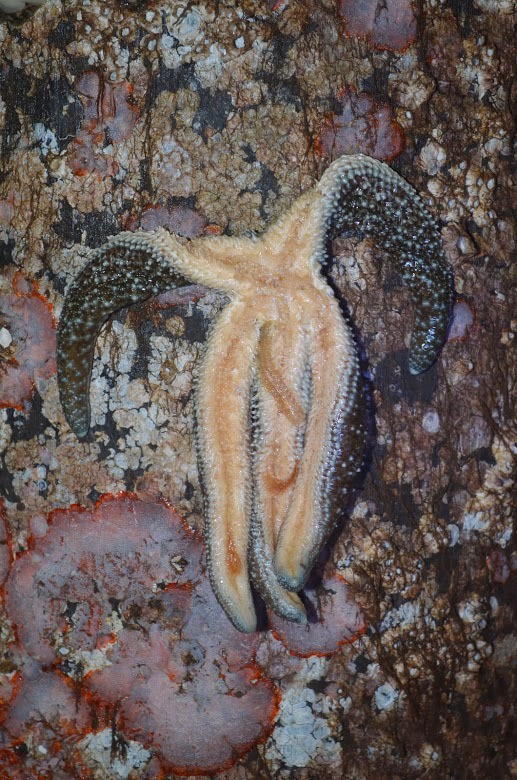The Pacific Northwest boasts the largest diversity and numbers of sea stars on Earth, but by all accounts, our population is experiencing a sudden, precipitous decline due to something called sea star wasting syndrome, which quickly turns these iconic creatures into puddles of goo.
First recorded in the U.S. in 1972, with periodic localized outbreaks occurring ever since, this disease has never been as extensive as the current epidemic. This event was first reported on the East Coast earlier this year, while Vashon Island claims the first record for the West Coast. At least 10 species of sea stars are affected, as well as a few closely related animals in the echinoderm family, such as sea urchins and sea cucumbers. It has been seen from Orange County to Alaska and from New Jersey to Maine, and in some places it is almost apocalyptic in scale.
Symptoms in sea stars begin with white lesions and a loss of internal body pressure. This loss causes them to deflate and literally lose their grip. The disease progresses rapidly, and in a matter of hours, they disintegrate, arms twist, fall off, crawl away and eventually turn to mush. Because the sea star literally falls apart while still living, some have coined it the “sea star zombie apocalypse.”
This seemed true at the north end on Dec. 3, when the Vashon Beach Naturalists held a beach walk. The group witnessed firsthand the devastating carnage of dismembered sea star arms littering the beach, while most of the remaining sea stars looked to be melting.
Although precise numbers are hard to come by, sea stars in Washington, British Columbia and California seem hardest hit, especially in sheltered bays and the Salish Sea, while the more exposed, wave-flushed areas seem to be faring much better. A research station in Monterey Bay, Calif., found no evidence of wasting in mid-October, but by early November, half of the most common species were afflicted, and the overall population was lower than ever recorded in the station’s 14-year history. Some species disappeared entirely. It is shocking how fast it can wipe out entire populations of sea stars.
Scientists do not yet have an answer for what causes this disease, but nationwide they are working to identify whether it is caused by a virus, bacterium, changes in water chemistry or, more likely, a combination of factors. It is also not clear if all the past wasting events share the same cause, but studies have strongly implicated warmer water temperatures. This year however, the surface waters of the Pacific are reported to be colder than average. Interestingly, the wasting symptoms are typical to what ecologists and aquarium workers observe after stressful events like low salinity and oxygen or too-warm temperatures.
Ocean acidification is being considered as a cause, but some experts discount it because acidification is pervasive and the outbreaks of this disease are localized. Nevertheless, strong winds can pull deeper high-CO2 waters towards the ocean’s surface, leading to temporary localized increases in acidification.
Although expert hypotheses abound, many in the public point to Fukushima. While radiation poisoning on such a scale would likely affect far more than just the echinoderms, as of this writing there are no other diseased and collapsing populations. Tests of tuna off the coast of Japan do show increased radioactivity, but at doses still less than that found in a single banana. The Washington State Department of Health has also been unsuccessful in finding increased radioactivity in fish caught in our own waters.
Many ecologists also note that the West Coast had a population explosion of sea stars in recent years. In the same way dense stands of trees aid the spread of pine beetles, the surplus of sea stars may have facilitated the severity of the current outbreak. This could be a striking example of the normal boom and bust cycle of natural populations. And because sea stars have experienced this before, it suggests some sort of pathogen lies at the heart, with stressful environmental conditions possibly increasing susceptibility.
Regardless of the cause, Vashon’s sea stars are wasting away before our eyes. The Vashon Beach Naturalists will again host a free public beach walk at the north end on New Year’s Eve, and although we will seek all kinds of critters, we are especially interested in the state of the sea stars. Will there be any healthy ones left? Come and help us find out.
— Adria Magrath is a biologist, teacher and Vashon Beach Naturalist.
New Year’s Eve Beach Walk
The Vashon Beach Naturalists will hold a starlight beach walk for low-tide sea life viewing. Bring flashlights, boots and warm clothing. 8:30 p.m. Tuesday, Dec. 31, at the north-end ferry dock.



